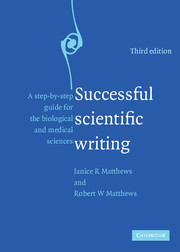Book contents
- Frontmatter
- Contents
- Preface
- Preface to the third edition
- 1 PREPARING TO WRITE
- 2 COMPOSING A FIRST DRAFT
- 3 VISUAL SUPPORT FOR THE WRITTEN WORD
- 4 VISUAL SUPPORT FOR THE SPOKEN WORD
- 5 REVISING TO INCREASE COHERENCE
- 6 IMPROVING WORD CHOICE, AND SYNTAX STYLE
- 7 ATTENDING TO GRAMMAR, NUMBERS, AND OTHER MECHANICS
- 8 THE REST OF THE STORY
- Appendix 1 Suggested responses to exercises
- Appendix 2 Excerpts from “Uniform requirements for manuscripts submitted to biomedical journals: Writing and editing for biomedical publication”
- Selected resources
- Index
5 - REVISING TO INCREASE COHERENCE
- Frontmatter
- Contents
- Preface
- Preface to the third edition
- 1 PREPARING TO WRITE
- 2 COMPOSING A FIRST DRAFT
- 3 VISUAL SUPPORT FOR THE WRITTEN WORD
- 4 VISUAL SUPPORT FOR THE SPOKEN WORD
- 5 REVISING TO INCREASE COHERENCE
- 6 IMPROVING WORD CHOICE, AND SYNTAX STYLE
- 7 ATTENDING TO GRAMMAR, NUMBERS, AND OTHER MECHANICS
- 8 THE REST OF THE STORY
- Appendix 1 Suggested responses to exercises
- Appendix 2 Excerpts from “Uniform requirements for manuscripts submitted to biomedical journals: Writing and editing for biomedical publication”
- Selected resources
- Index
Summary
Put it before them briefly so they will read it, clearly so they will appreciate it, picturesquely so they will remember it and, above all, accurately so they will be guided by its light.
– Joseph PulitzerAlmost every writer needs to correct and improve his first drafts. Those who can write a finished document and first draft at the same time are few, and might be compared to the rare musical prodigy who can play symphonies without ever taking a music lesson. Revision most often is the step in scientific writing that separates the beginner from the master craftsman. It's the reason why professional writers have such big wastebaskets! They keep working on a piece until it is right.
Two processes are involved in written communication. The first, in your mind, is the selection of words to express your thoughts. The second, in the mind of the reader, is the conversion of the written words into thoughts. The essential difficulty is in trying to ensure that the thoughts created in the mind of the reader are the same thoughts that were in your mind. Revisions are just a way to fine-tune this transfer. Coherence – the quality of being logically and aesthetically consistent – is the desired result.
WORK EFFICIENTLY
Do you remember the Process Approach that was presented in Chapter 1? It counseled breaking the writing task into discrete stages, each to be approached by the most systematic, efficient, and effective means that could be determined.
- Type
- Chapter
- Information
- Successful Scientific WritingA Step-by-Step Guide for the Biological and Medical Sciences, pp. 103 - 124Publisher: Cambridge University PressPrint publication year: 2007



